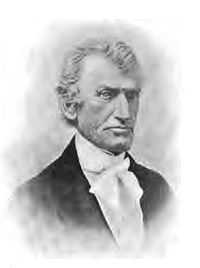Thomas Ruffin

Thomas Ruffin (1787–1870) was an American jurist and Justice of the North Carolina Supreme Court from 1829 to 1852 and again from 1858 to 1859. He was Chief Justice of that Court from 1833 to 1852.
Biography
Thomas Ruffin was born on November 17, 1787 at the residence of his maternal grandfather Thomas Roane at Newington in King and Queen County, Virginia. Ruffin graduated from Princeton University and studied law in North Carolina under Archibald Murphey. He commenced the practice of law in Hillsborough, North Carolina, where he also farmed. He was elected to several terms in the North Carolina House of Commons and served as a Superior Court judge from 1816 to 1818 and from 1825 to 1828. In 1828, the state called upon Ruffin to bring the State Bank of North Carolina out of debt as its new President, which he did in one year. The legislature then named him to the state Supreme Court.
"The election of former Superior Court Judge and State Bank President Ruffin to the bench in 1829 effectively ensured the North Carolina Supreme Court's survival", according to Martin Brinkley (see link below). Ranked by Harvard Law School Dean Roscoe Pound as one of the ten greatest jurists in American history, Ruffin singlehandedly transformed the common law of North Carolina into an instrument of economic change. His writings on the subject of eminent domain--the right of the state to seize private property for the public good—paved the way for the expansion of railroads into North Carolina, enabling the "Rip Van Winkle State" to embrace the industrial revolution. Ruffin's opinions were cited as persuasive authority by appellate tribunals throughout the United States. The influence his decisions exercised upon the nascent jurisprudence of the states then known as the Southwest (Alabama, Louisiana, Tennessee, Arkansas, and Mississippi), which were settled by emigrating North Carolinians in large numbers, made Ruffin a celebrated figure at home. Public veneration of the "stern prophet," as Ruffin was called, preserved his Court from destruction by populist politicians.
_-_NARA_-_525615.jpg)
Together, Justice William Gaston and Ruffin, whom his colleagues elected Chief Justice in 1833 (by a coin toss, according to a popular but probably apocryphal account), dominated their less-talented brother judges, rendering treatise-like opinions that inspired one contemporary to exclaim: "No State of the Union . . . not even the United States, ever had a superior Bench; few ever had its equal."
Ruffin wrote the decision in the case of North Carolina v. Mann (1829), which sanctioned the "absolute" power of a master over a slave.[1]
Ruffin was also the author of Dougherty v. Stepp (1835),[2] a staple of first-year Torts classes in American law schools used to teach students about the tort of trespass upon real property.[3]
Ruffin retired in 1852 to his plantation in Alamance County, but the legislature called him back to the Court in 1858. He retired again after about one year, at the age of 78. His home after the end of the American Civil War until his death in 1870, the Ruffin-Roulhac House at Hillsborough, was listed on the National Register of Historic Places in 1971.[4][5]
In addition to his legal and political career, Ruffin was an innovative farmer, and was president of the state's Agricultural Society from 1854 to 1860.
Ruffin was also a trustee of the University of North Carolina at Chapel Hill for some 24 years.
References
- ↑ "GreeneSpace: Judging history at UNC". Greenespace.blogspot.com. 2006-05-02. Retrieved 2012-10-17.
- ↑ Dougherty v. Stepp18 N.C. 371 (N.C. 1835).
- ↑ See, e.g., James Barr Ames and Jeremiah Smith, A Selection of Cases on the Law of Torts (3rd ed., 1910), Vol. 1, pp. 59-60; Richard Epstein, Cases and Materials on Torts (8th ed., 2004), pp. 9-10.
- ↑ "National Register Information System". National Register of Historic Places. National Park Service. 2010-07-09.
- ↑ John B. Wells, III (July 1971). "Ruffin-Roulhac House" (PDF). National Register of Historic Places - Nomination and Inventory. North Carolina State Historic Preservation Office. Retrieved 2015-02-01.
Further reading
Timothy S. Huebner, The Southern Judicial Tradition: State Judges and Sectional Distinctiveness, 1790-1890 (1999).
External links
| Wikimedia Commons has media related to Thomas Ruffin. |
- Supreme Court Official History by Martin H. Brinkley
- NC Business Leader magazine
- Thomas Ruffin Papers - University of North Carolina
- The Perils of Public Homage: Thomas Ruffin and State v. Mann in History and Memory
- The Perils of Public Homage: State v. Mann and Thomas Ruffin in History and Memory (details)
- Picture of Thomas Ruffin from UNC
| Legal offices | ||
|---|---|---|
| Preceded by Leonard Henderson |
Chief Justice of North Carolina Supreme Court 1833 - 1852 |
Succeeded by Frederick Nash |
|